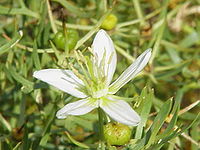
Photo from wikipedia
When considering food security and huge market interest, a high-efficiency method to ensure the authenticity of the food product is necessary. For this goal, spectral imaging was explored for quantitative… Click to show full abstract
When considering food security and huge market interest, a high-efficiency method to ensure the authenticity of the food product is necessary. For this goal, spectral imaging was explored for quantitative detection of Irish organic wheat flour (OWF) adulterated with common wheat flour (WF), cassava flour (CaF) and corn flour (CoF). Hyperspectral images (900–1700 nm) of OWF samples with a series of adulteration percentages were collected. The acquired spectra were pre-processed by second derivative (2nd Der) and standard normal variate (SNV) before modelling. Then partial least squares regression (PLSR) and principal component regression (PCR) were employed for quantitative analysis of adulteration proportion of CoF, CaF and WF in OWF. To develop more effective simplified models, three groups of feature wavelengths were selected from the loading plots of principal component analysis (PCA), and first-derivative and mean centering iteration algorithm (FMCIA). The models developed using FMCIA were better than PCA. After, the corresponding feature wavelengths were further reduced based on model regression coefficients (RC). The optimal result of admixture detection was emerged by the RC-FMCIA-PLSR model, with a determination coefficient of prediction (R2P) of 0.973 and a root mean square error of prediction (RMSEP) of 0.036 for OWF adulterated with CoF, R2P of 0.986 and RMSEP of 0.026 for OWF adulterated with CaF, and R2P of 0.971 and RMSEP of 0.038 for OWF adulterated with WF. Visualization maps were generated by calculating the spectral response of each pixel on flour samples. This result indicates that spectral imaging integrated with multivariate analysis has the potential to authenticate the admixtures in specific wheat flour in the range of 3–75% (w/w).
Journal Title: Journal of Food Engineering
Year Published: 2017
Link to full text (if available)
Share on Social Media: Sign Up to like & get
recommendations!